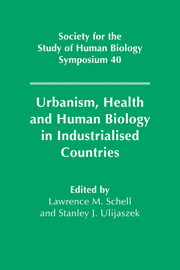Book contents
- Frontmatter
- Contents
- List of contributors
- Part I The urban environment
- Part II Epidemiology
- Part III Poverty and health
- 9 Urban poverty and nutrition in the United Kingdom
- 10 Poverty, nutrition and obesity in the USA
- 11 Nutritional status and its health consequences among low-income urban pregnant women: diet and environmental toxicants
- Part IV Behavior and stress
- Part V The future
- Index
11 - Nutritional status and its health consequences among low-income urban pregnant women: diet and environmental toxicants
Published online by Cambridge University Press: 06 January 2010
- Frontmatter
- Contents
- List of contributors
- Part I The urban environment
- Part II Epidemiology
- Part III Poverty and health
- 9 Urban poverty and nutrition in the United Kingdom
- 10 Poverty, nutrition and obesity in the USA
- 11 Nutritional status and its health consequences among low-income urban pregnant women: diet and environmental toxicants
- Part IV Behavior and stress
- Part V The future
- Index
Summary
Editors' introduction
This chapter develops the theme that cities are characterised by multiple overlapping microenvironments. Johnston and Gordon-Larsen (chapter 10) showed that the nutritional status of poor urban adolescents differs from the nutritional status of US adolescents nationally. Czerwinski shows that the diets of poor urban gravidae also differ from national reference values. Whereas many investigators relate diet directly to health outcomes such as growth, obesity and cardiovascular function, Czerwinski's analysis reveals that the interactions between diet, nutrition and pollutants are complex. Many people are exposed to pollutants through the foods they eat, such that being well nourished can also mean having a higher pollutant burden. Using new data from the Albany Pregnancy–Infancy Lead Study, he shows that the urban poor experience greater exposure to toxicants such as lead, and their dietary patterns may expose them to more food-borne toxicants. Furthermore, dietary items that might moderate toxicant absorption may be less commonly consumed by the urban poor. Pollutants, as relatively new factors in urban environments, interact with one of the oldest, social stratification, to produce a greater health risk for the urban poor.
Introduction
This chapter will examine the relationship between diet and exposure to environmental toxicants among poor pregnant women living in urban environments.
- Type
- Chapter
- Information
- Urbanism, Health and Human Biology in Industrialised Countries , pp. 210 - 228Publisher: Cambridge University PressPrint publication year: 1999
- 1
- Cited by



